Intercom for In-App Messaging: Features, Pricing, and Review

Looking for an effective in-app messaging tool and wondering if Intercom is the best option for your SaaS company?
With numerous Intercom alternatives, it can be challenging to make a final decision.
In this article, we’ll delve into precisely that – helping you determine whether Intercom is the ideal choice for your in-app messaging needs. We’ll explore its features, pricing, and offer a comprehensive review to aid in your decision-making process.
Let’s get started!
TL;DR
- Intercom is a good choice for in-app messaging and it comes with features such as self service support, in-app resource center, onboarding checklist, and in-app messaging.
- While Intercom is a flexible and popular solution when it comes to customer service, there are certain use cases where it will likely fall short compared to other options.
- If you’re in any of these scenarios, you should look for an alternative platform for your needs:
-
- Onboarding and Adoption: If onboarding new users and driving product adoption are your primary use cases then Intercom may not be the best choice. Its Product Tours add-on is quite limited compared to dedicated adoption platforms (and costs almost as much).
- Budget Constraints: Early-stage SaaS companies with a limited budget should be wary of Intercom’s pricing model. Its entry-level plan starts at an affordable $74/month but getting the Product Tours add-on and extra team seats could lead to your subscription cost skyrocketing.
- Mobile Apps: While Intercom’s core features like the live chat messenger work on mobile apps, its product tours add-on is only compatible with desktop platforms.
- If you’re looking for a better option for in-app messaging, Userpilot exceeds both functionality and value for money compared to Intercom.
- Ready to see Userpilot in action? Schedule a demo today to explore its powerful in-app messaging capabilities firsthand.
![]()
Looking for a Better Alternative for In-app messaging? Try Userpilot

What is Intercom?
Intercom is a customer service platform. It offers customizable live chat widgets, omnichannel support capabilities, and integrations with over 300 apps. While Intercom is primarily a support solution, it does have add-ons that offer other functionalities such as product tours.
The Product Tours add-on contains features that aid onboarding, adoption, and feature discovery. Intercom’s product tours can include UI patterns like modals and tooltips as well as other media formats such as microvideos.

Must have features of in-app messaging tools
Overall, the best tool for your business will depend on your specific needs and goals. When choosing an in-app messaging tool, it’s important to consider factors such as:
- Targeting and segmentation: The ability to target messages to specific users or user segments based on behavior, preferences, or other attributes.
- Automation and scheduling: The ability to automate the delivery of messages based on specific triggers or user actions.
- A/B testing: The ability to test different message content, formats, or delivery methods to determine which is most effective.
- Personalization: The ability to personalize messages based on user behavior, goals, or other attributes.
- Analytics and insights: The ability to track message performance, such as open rates, click-through rates, and conversion rates, and gain insights into user behavior and preferences.
- Different UI patterns: The ability to deliver in-app messages with different patterns: tooltips, modals, pop-ups, or slideouts.
Overall, an in-app messaging tool should provide a robust and flexible platform for delivering targeted and personalized messages to users within your application.
Intercom features for in-app messaging
Intercom’s in-app support capabilities center around its live chat widget and help center builder. The help center supports 45 languages, countless third-party integrations from the Intercom App Store, and automated welcome messages.
Here’s an overview of Intercom’s in-app support capabilities:
- Live Chat: Intercom’s live chat is highly customizable, compatible with countless integrations, and lets you style its appearance to bring it in line with your existing product UI (or brand palette). You can also reorder buttons or toggle their visibility as needed.
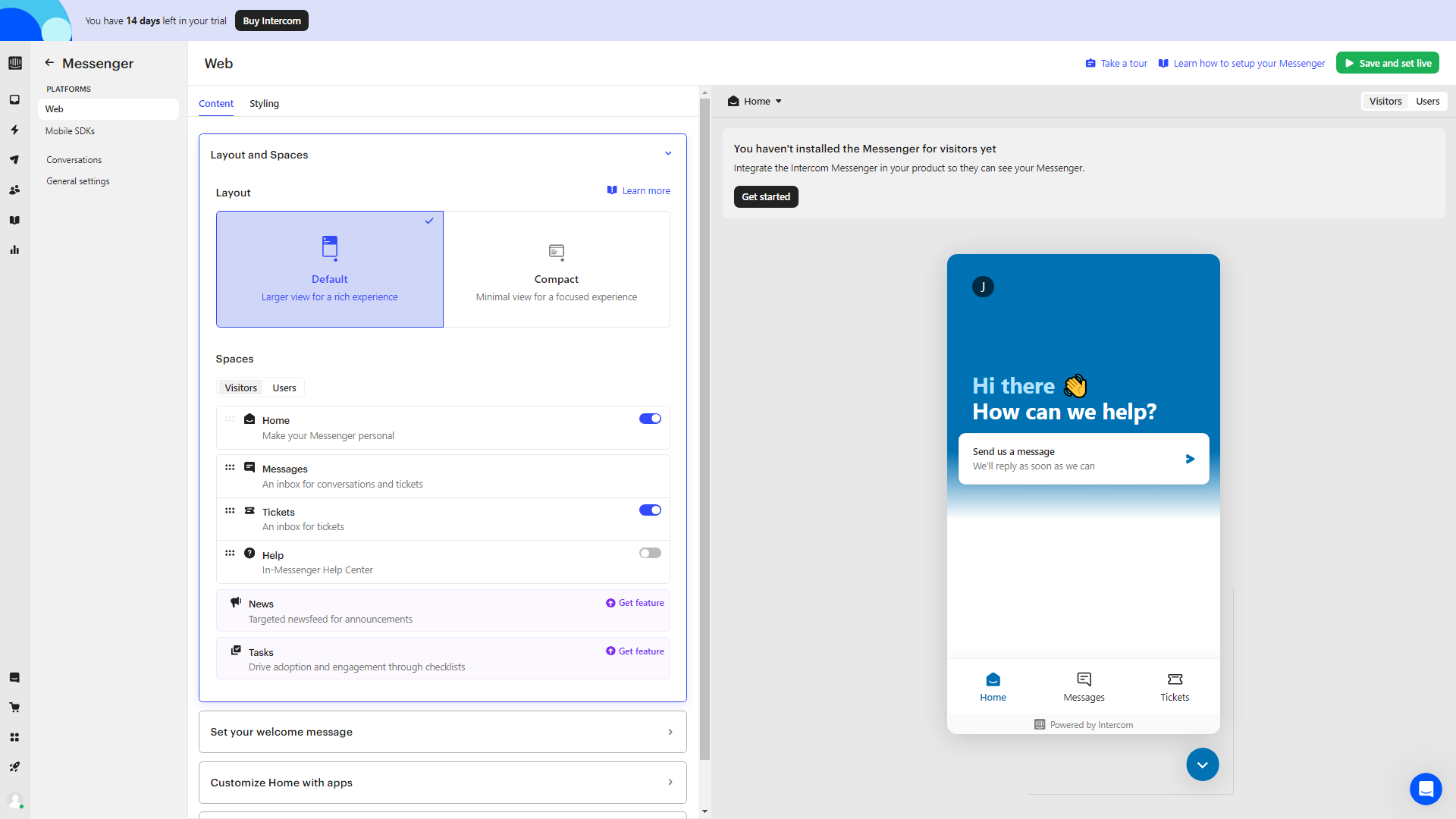
- Help Center: Intercom’s help center can be set up in multiple languages, use custom domains, and integrated with third-party apps. You’ll also be able to change up the layout, insert your logo, and set a (multi-lingual) welcome message to greet users who land at your help center.
Note: Intercom’s multilingual help centers are only available on the Pro tier and higher which means users on the entry-level Starter plan ($74/month) won’t be able to use this feature. Help articles aren’t automatically translated so you’ll need to rewrite them manually as well.
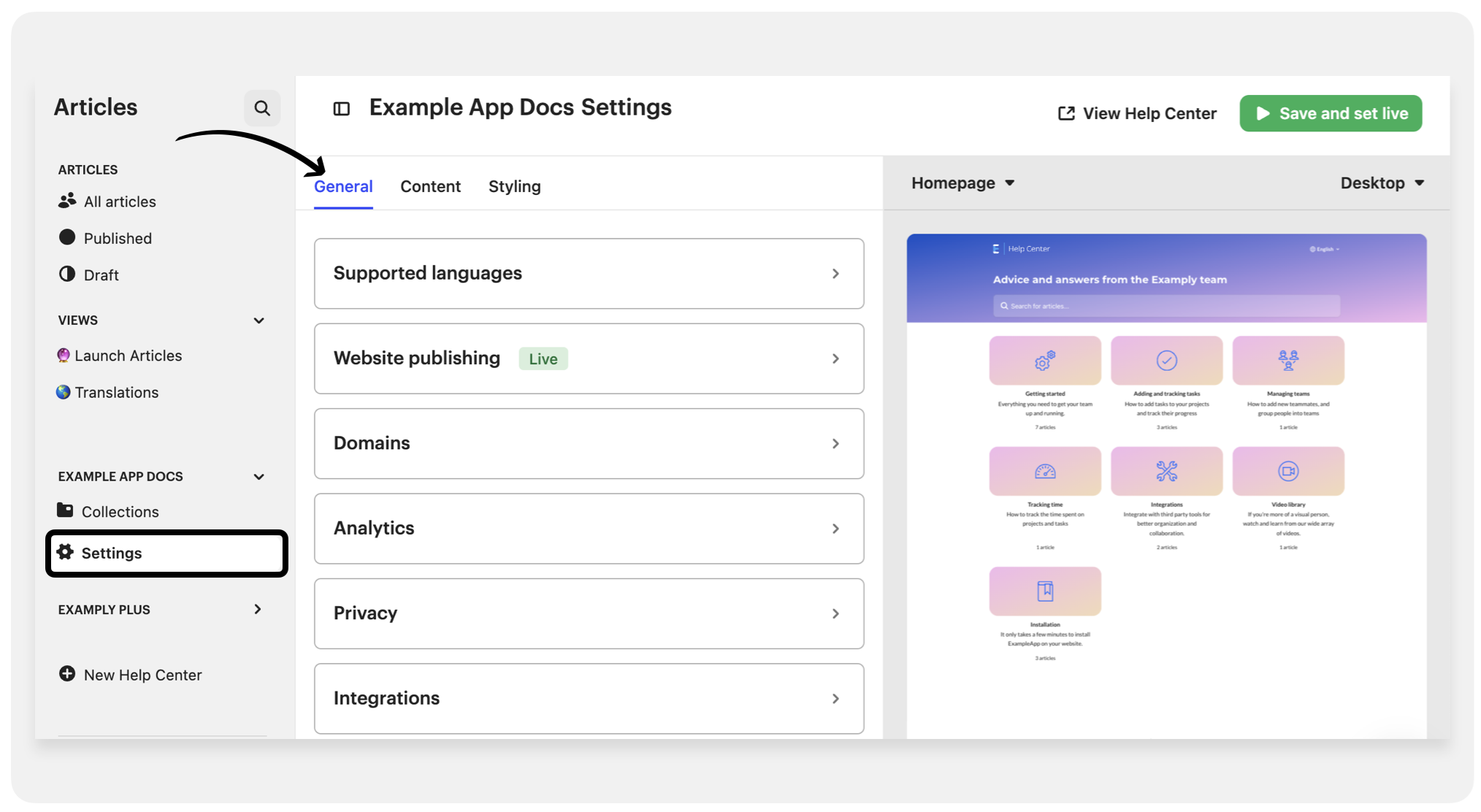
- Content Analytics: Intercom’s content engagement analytics can show you granular insights on the performance of each help center article. You’ll be able to see the number of views, conversations, and reactions and then compare those numbers for different date ranges.
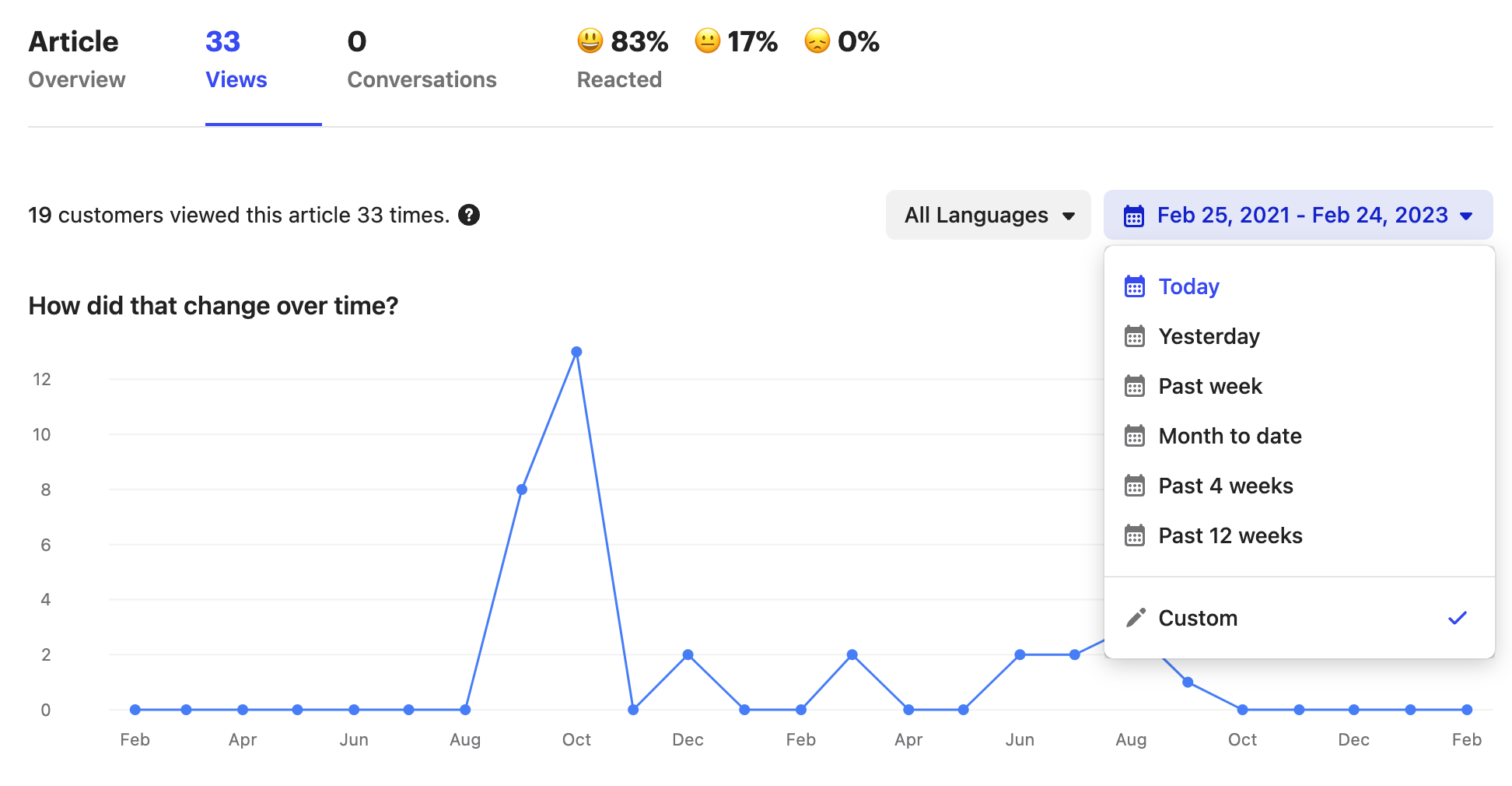
Intercom’s self service support
Self-service support helps users solve their own problems so they get faster resolution times without needing to take up the time of your support representatives. Intercom has self-service support features like a help center, chatbot, and third-party knowledge base integrations.
Here’s how you can use Intercom to create a self-service customer experience:
- Help Center: The Intercom help center lets you publish resources in multiple languages, host them on a custom domain, and embed third-party apps if needed. Any help articles published here will also be used to feed information to your support chatbots down the line.
Note: Intercom’s multilingual help centers are only available on the Pro tier and higher which means users on the entry-level Starter plan ($74/month) won’t be able to use this feature. Help articles aren’t automatically translated so you’ll need to rewrite them manually as well.

- Fin Chatbot: The Fin chatbot is built on GPT-4 which allows it to respond naturally while drawing data from multiple sources. It can reference articles in your help center, look at conversation data, search through public URLs, or pull information from integrations.
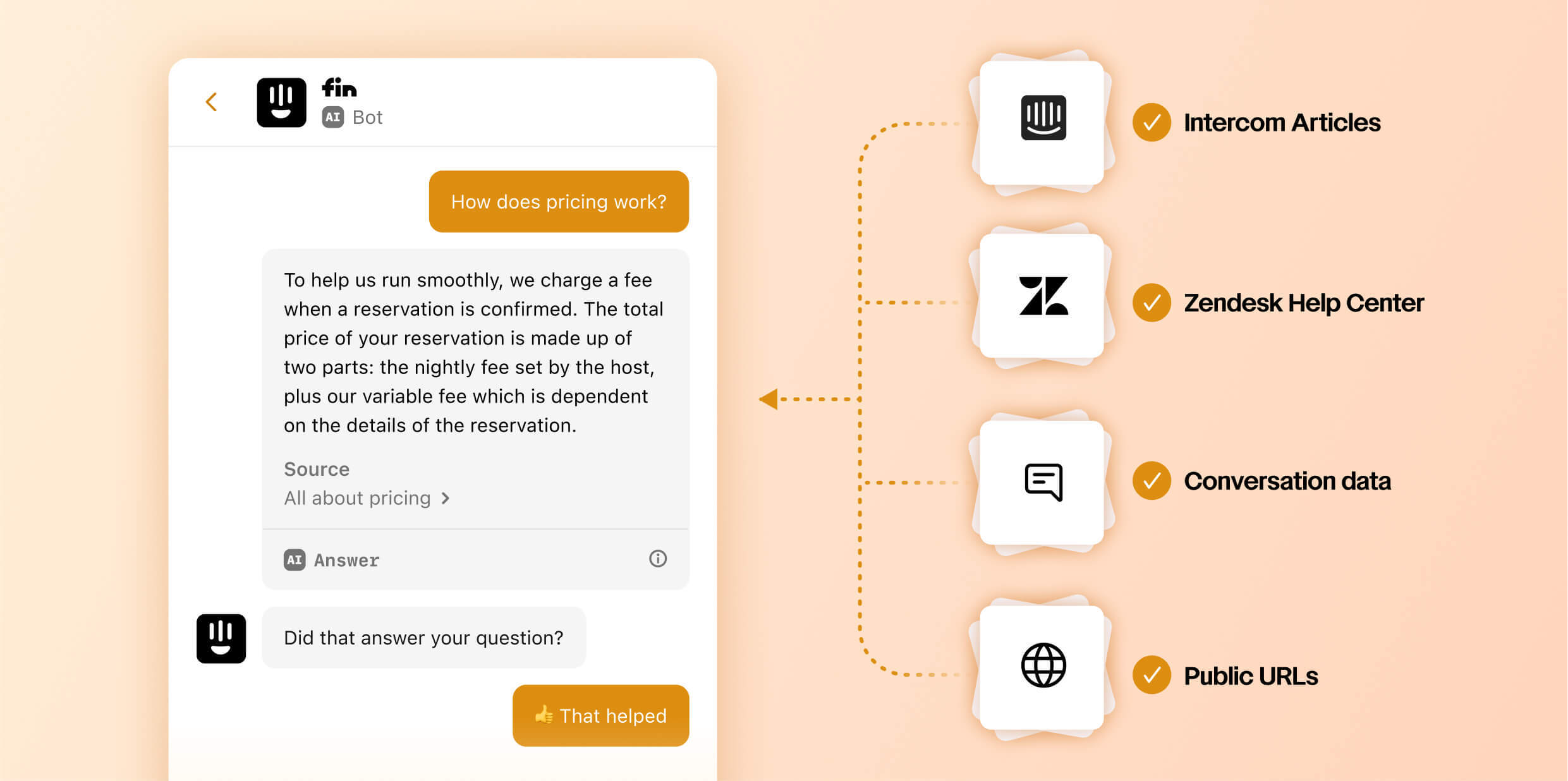
- Third-Party Integrations: Intercom has integrations for external knowledge base solutions. There are over 20 knowledge base tools that Intercom can integrate with to import articles, videos, and other support data. This includes Zendesk, Freshdesk, HelpDocs, and more if you are on the Pro plan (the Starter plan drastically restricts available integrations).
Intercom’s in-app resource center
In-app resource centers make it possible for users to access help articles from within the product itself so they can solve problems themselves.
While Intercom doesn’t have a dedicated in-app resource center, it does let you enable searches through the chat messenger widget.
- Widget: To let users search through help center articles through the chat widget, you’ll need to go to Messenger > Platforms > Web > Content > Spaces and toggle the help center on. You can also enable this feature on your mobile app through Mobile SDKs > Content > Spaces.
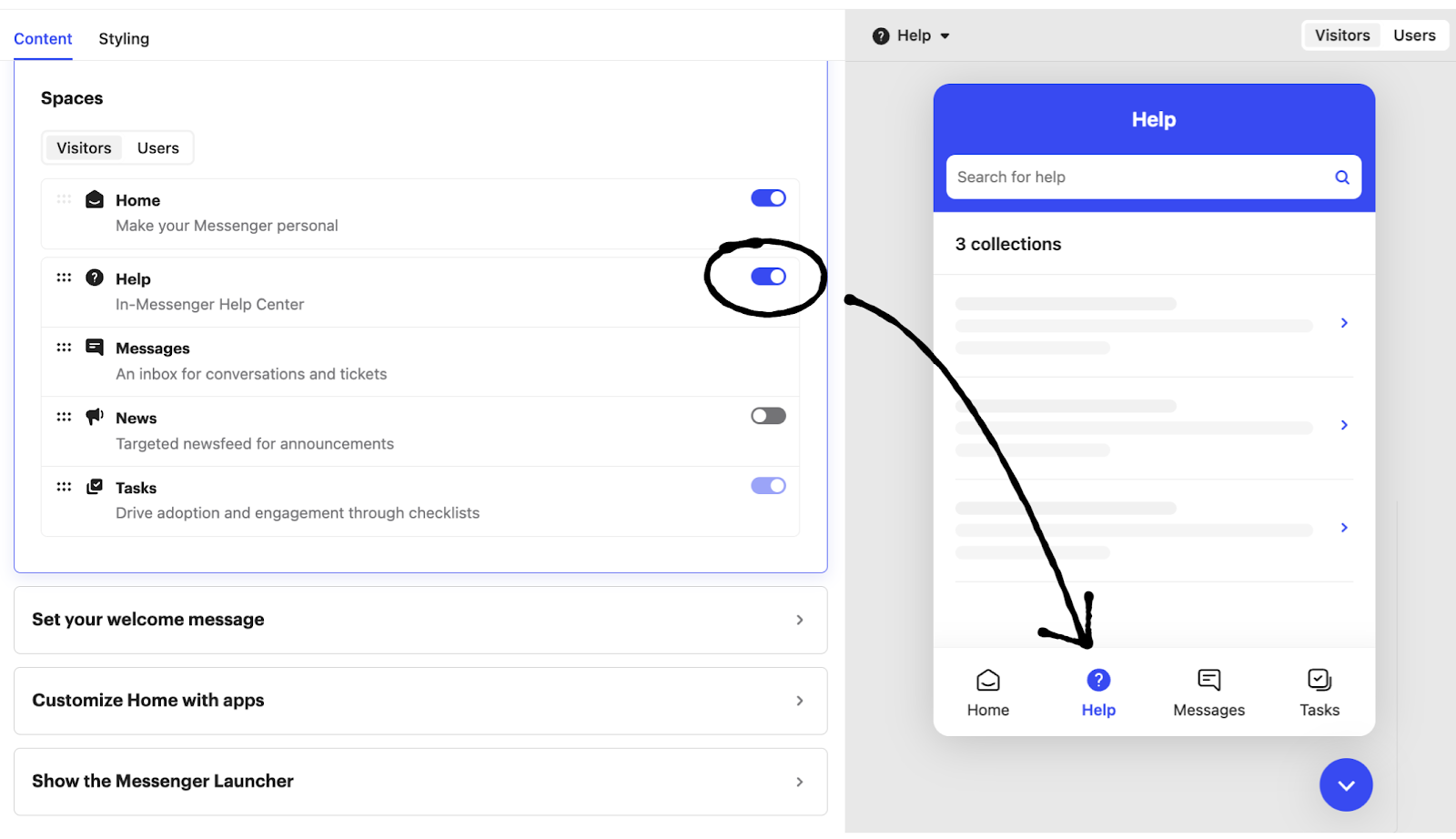
- Features: The Intercom help center lets you upload resources in multiple languages, use custom domains, and style the interface to align it with your product UI or brand palette. These help center articles will also be used as a reference by chatbots when answering user questions.
Note: Intercom’s multilingual help centers are only available on the Pro tier and higher which means users on the entry-level Starter plan ($74/month) won’t be able to use this feature. Help articles aren’t automatically translated so you’ll need to rewrite them manually as well.
Intercom’s onboarding checklist
User onboarding checklists are the best way to guide new users towards the next step of their journey and encourage them to try core features. Intercom has a no-code checklist builder, multiple targeting rules, and two templates to get you started.
You’ll need to get the Product Tours add-on which costs $199/month on top of your existing Intercom subscription, to use checklists.
Here’s how you can use Intercom to create onboarding checklists:
- Intercom’s no-code checklist builder lets you add tasks, add completion time estimates for users, and set the criteria for certain tasks to automatically be marked as completed. You can also add a seemingly unlimited number of tasks (our testing exceeded 100 tasks).
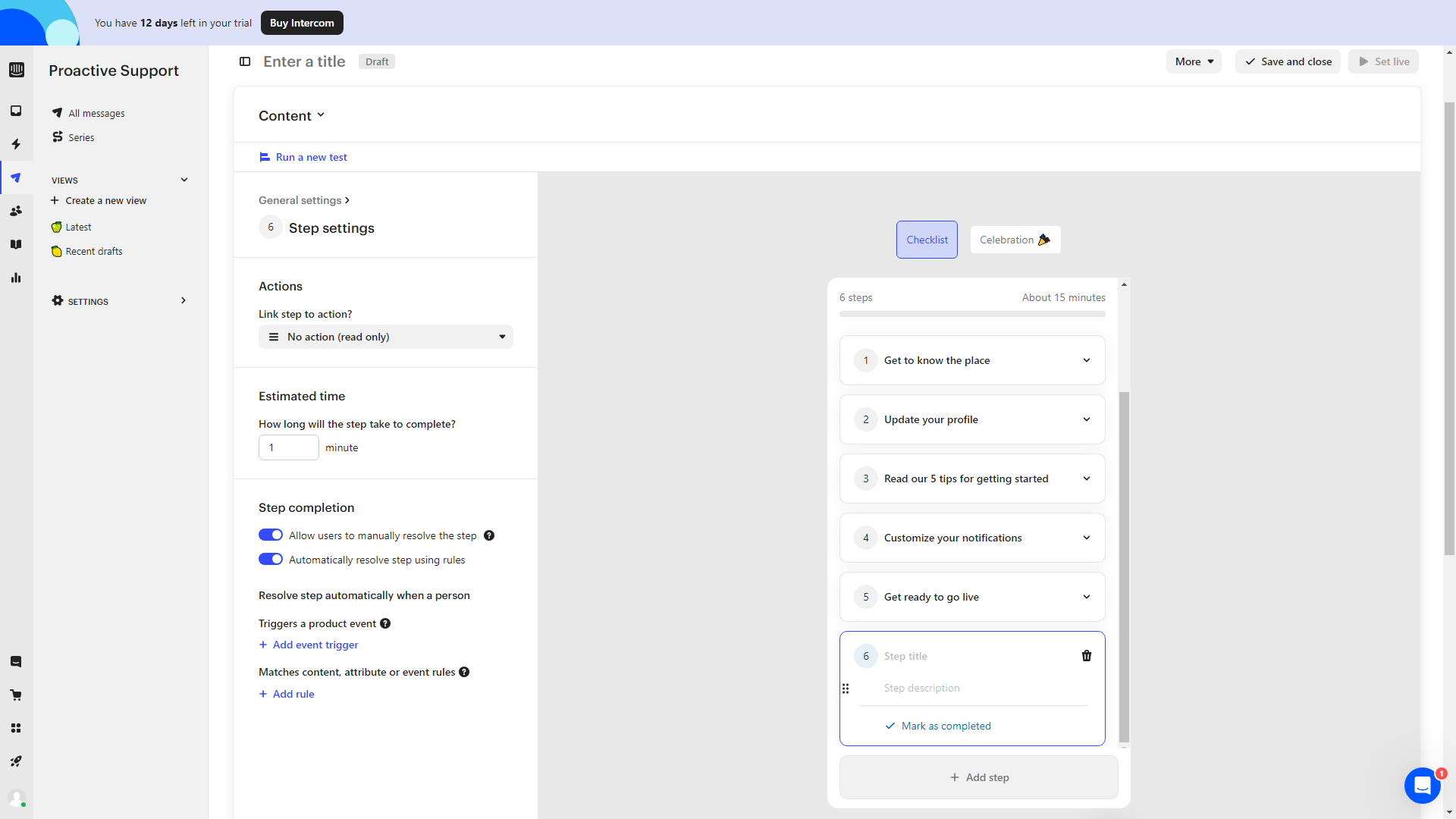
- Intercom’s targeting rules let you adjust when your checklists will appear based on the page a user is on, which segment they’re in, and other attributes such as company, country, signup date, etc. You can also trigger checklists by embedding the code snippet in a webpage.
- When building Intercom checklists, you have the option of starting from scratch or using one of the pre-built templates. There’s one template for onboarding new users and another template for feature discovery.

Intercom’s in-app messaging
In-app messaging lets you communicate with users from inside the app itself. Intercom has a few options for communicating with your users — some of which are available on the base product, while others require subscription add-ons to use.
Here’s how you can use Intercom to send in-app messages:
- Chat Widget: Intercom’s Messenger adds an in-app chat widget that your users can use to reach out to a support agent, send queries to a chatbot, or search through the help center (if you enable the “Help” option). You can also use it to schedule automated messages to users.

- Automated Popups: If you get the Product Tours add-on ($199/month), then you’ll be able to use Intercom’s UI patterns to send in-app messages. These include announcements, banners, tooltips, and multi-step product tours. You can also send push notifications to mobile users.

- Scheduling Settings: Intercom’s scheduling capabilities help you select the days, times, and start dates for in-app messages. For example, you could set a specific start/stop date for announcement messages so that they don’t advertise old features as “new” updates.
What are the pros and cons of Intercom?
Intercom’s pros
- Robust Live Chat: Intercom’s live chat widget is the most popular feature on the platform. You’ll be able to style the widget in accordance with your brand colors, choose which support options customers will see, and insert apps to create a self-serve experience.
- Product Tours Add-On: In addition to Intercom’s customer service capabilities, its Product Tours add-on offers support to new users during the onboarding and adoption phases. Features include a no-code builder, audience targeting, analytics reporting, and more.
- Extensive Integration Gallery: If Intercom’s built-in support/onboarding features aren’t enough, you can expand its native functionality using third-party integrations. Intercom’s App Store has over 300 tools to choose from with new solutions being added regularly.
Intercom’s cons
- Buggy Search Function: Searching through support tickets is a core task for Intercom users but this process is often laggy or refuses to work altogether by freezing the page. Intercom’s searchability shortcomings have been present for years with no fixes released.
- Confusing Navigation Interface: While Intercom does have a wide array of features, its user interface isn’t intuitive and it’ll take a lot of memorization (or trial-and-error) to figure out where everything is. There are many features that can (and should) be combined into one page.
- Support Response Times: Intercom is a customer service platform which is why it’s ironic that their support team isn’t able to reliably respond in a timely manner. Numerous customers have noted slow response times from support representatives when reviewing Intercom.
What do users say about Intercom?
Intercom users were impressed with the interaction features such as emojis, GIFs, and avatars:
“I really like the fact that you can send emojis, have an avatar, interact with the client and know what their tastes are as such, it is very interactive to the point that you can jump between chats recognizing each of the clients/agents.”
 Of course, other customers were upset by the lack of transparent billing, inadequate support experience, constant upsells, and restrictive feature limitations:
Of course, other customers were upset by the lack of transparent billing, inadequate support experience, constant upsells, and restrictive feature limitations:
“Purposely opaque and dishonest billing systems.
Incompetent staff.
Once you have it installed they exploit you for CONSTANT fee hikes.
Constant pitches to upgrade plans and required extra fees.
Unnecessary limitations on features”

Intercom’s pricing
Intercom’s plans start at $74/month on the entry-level plan and use custom pricing for the Pro tier or higher. There’s no free version available, but Intercom does offer a 14-day free trial that lets you test all features on the Starter tier before upgrading to a paid subscription.
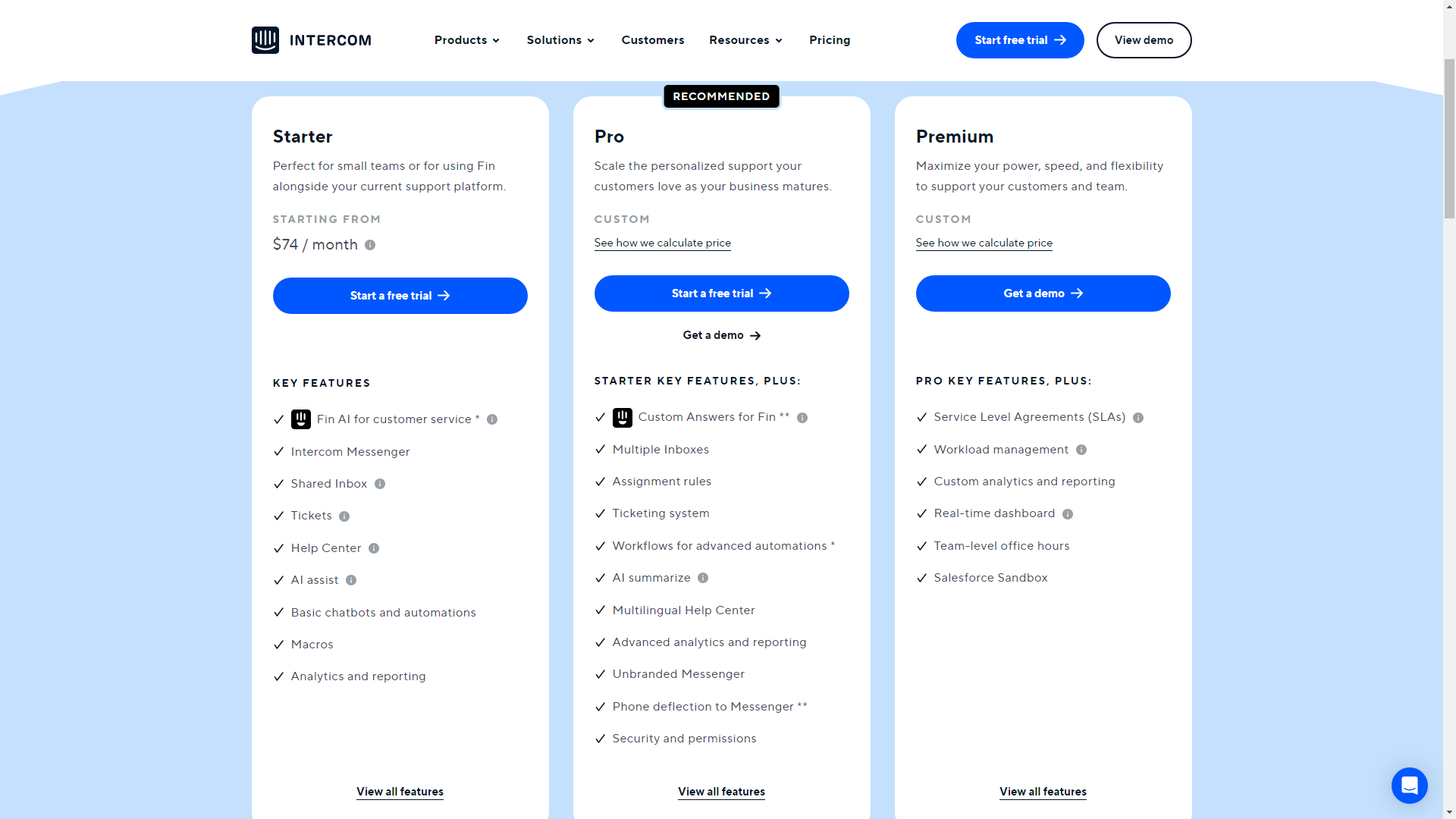
Intercom has three paid plans to choose from and different add-ons priced separately:
- Starter: Starts at $74/month and includes two team seats, and features like the messenger widget, automated chatbots, shared inbox, real-time tickets, help center, macros, and basic analytics reporting capabilities.
- Pro: Custom pricing based on the number of team seats and MAUs. It includes features like multiple inboxes, assignment rules, ticketing systems, localized help centers, and advanced automation/analytics.
- Premium: Custom pricing based on the number of team seats and MAUs. It includes features like a real-time dashboard, custom analytics, workload management, and a service level agreement.
In addition to the base subscription cost, you’ll need to pay an additional $199/month if you want to use the Product Tours add-on. This means that, even on the Starter plan, you’d still be paying almost $300/month in total if you get the Product Tours add-on to go with it.
3 Reasons why you might need an Intercom alternative
While Intercom is a flexible and popular solution when it comes to customer service, there are certain use cases where it will likely fall short compared to other options.
If you’re in any of these scenarios, you should look for an alternative platform for your needs:
- Onboarding and Adoption: If onboarding new users and driving product adoption are your primary use cases then Intercom may not be the best choice. Its Product Tours add-on is quite limited compared to dedicated adoption platforms (and costs almost as much).
- Budget Constraints: Early-stage SaaS companies with a limited budget should be wary of Intercom’s pricing model. Its entry-level plan starts at an affordable $74/month but getting the Product Tours add-on and extra team seats could lead to your subscription cost skyrocketing.
- Mobile Apps: While Intercom’s core features like the live chat messenger work on mobile apps, its product tours add-on is only compatible with desktop platforms.
Userpilot – A better alternative for in-app messaging
In-app support can increase customer satisfaction and retention rates. Userpilot has native in-app support features like resource centers and native tooltips as well as third-party integrations with popular support tools like Intercom to help you cover all your bases.
Here’s an overview of Userpilot’s in-app support capabilities:
- Resource center: Userpilot in-app resource centers let you add flows, checklists, external links, tutorial videos, external knowledge bases, and chatbots. You’ll also be able to view resource center analytics so you can check its performance.

- Native tooltips: In-app support must be proactive — which is why you should insert tooltips that guide users before they even think to open the resource center. Userpilot lets you add native tooltips that appear whenever users hover over an element or click on the info badge.
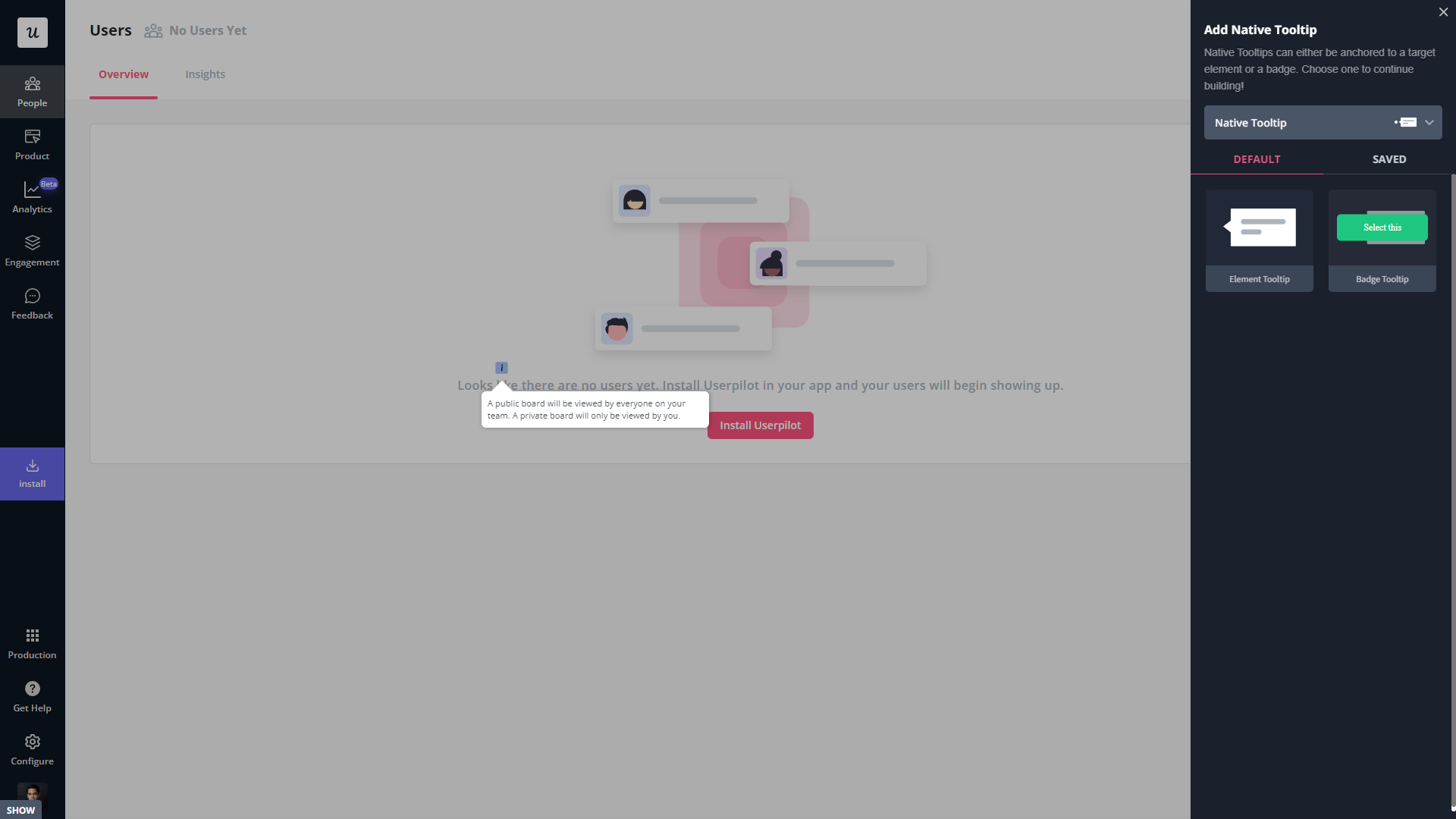
- Contextual flows: Userpilot’s trigger settings let you create contextual flows that automatically appear when a user reaches a certain page or performs a specific action. This can be used to offer in-app guidance and support whenever users try out a feature for the first time.
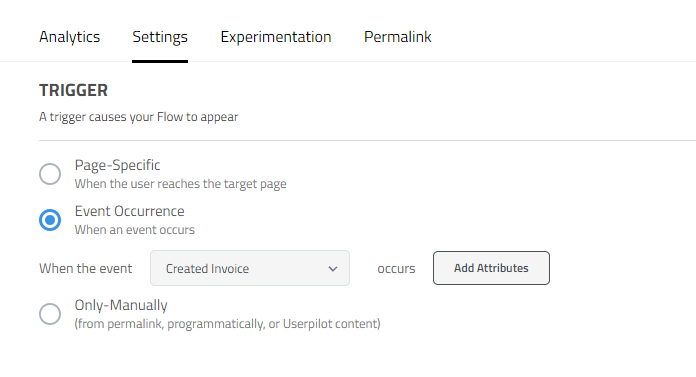
- Intercom integration: While Intercom is famous for its live chat embeds, you can do more than that by integrating it with Userpilot. You’ll see which events a user has done within Userpilot and whether or not they’ve completed onboarding to personalize support accordingly.
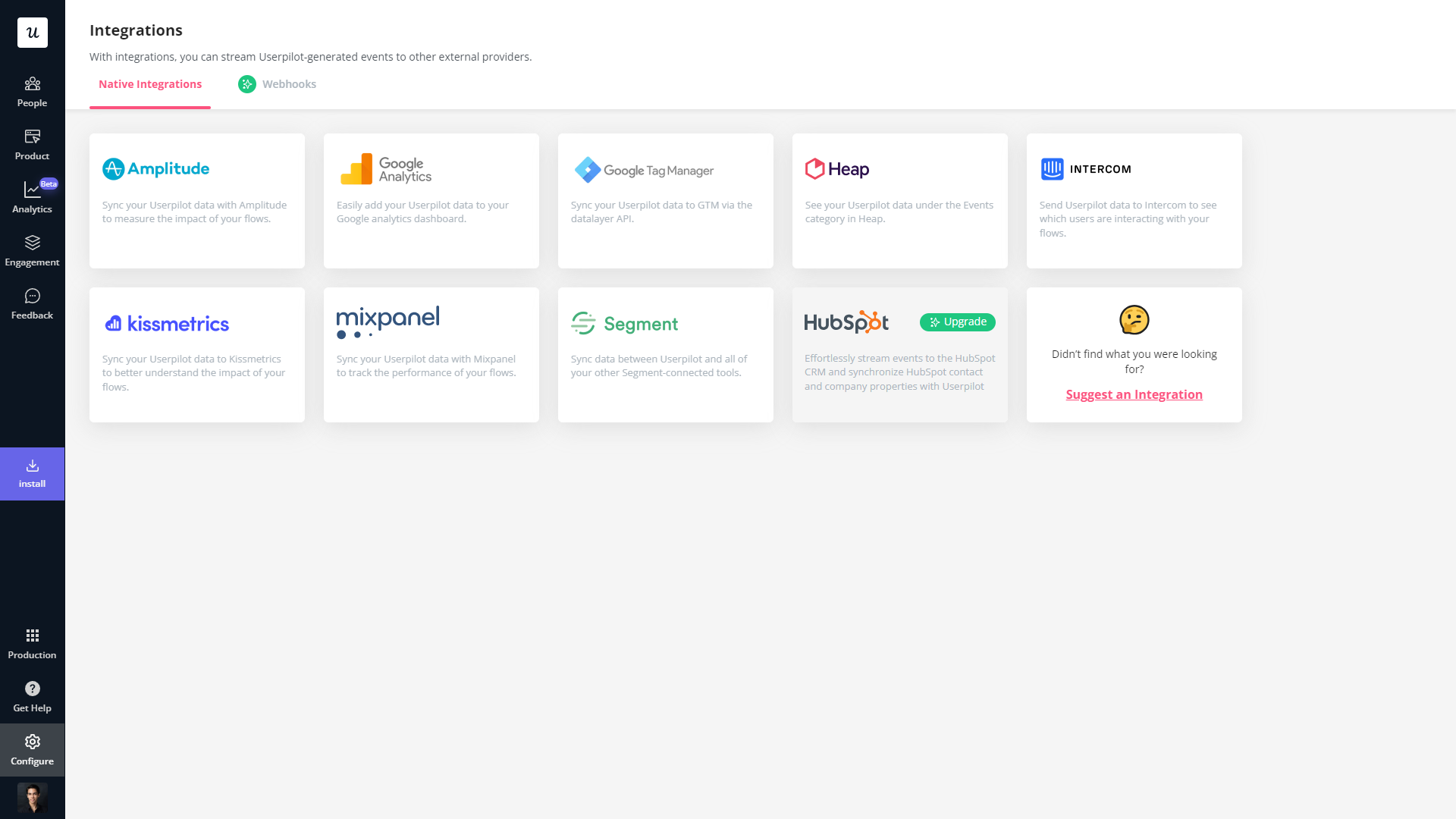
Userpilot’s self service support
Self-service support helps users solve problems themselves instead of having to reach out to a representative. Userpilot’s no-code resource center makes onboarding guides and product documentation easily accessible to users from within your product.
Here’s how you can use Userpilot to create a self-service customer experience:
- No-code builder: Userpilot’s no-code resource center lets you add modules without writing a single line of code. Module options include links, videos, flows, custom JavaScript functions, and checklists. You can also group modules into sections to help users navigate the resource center.
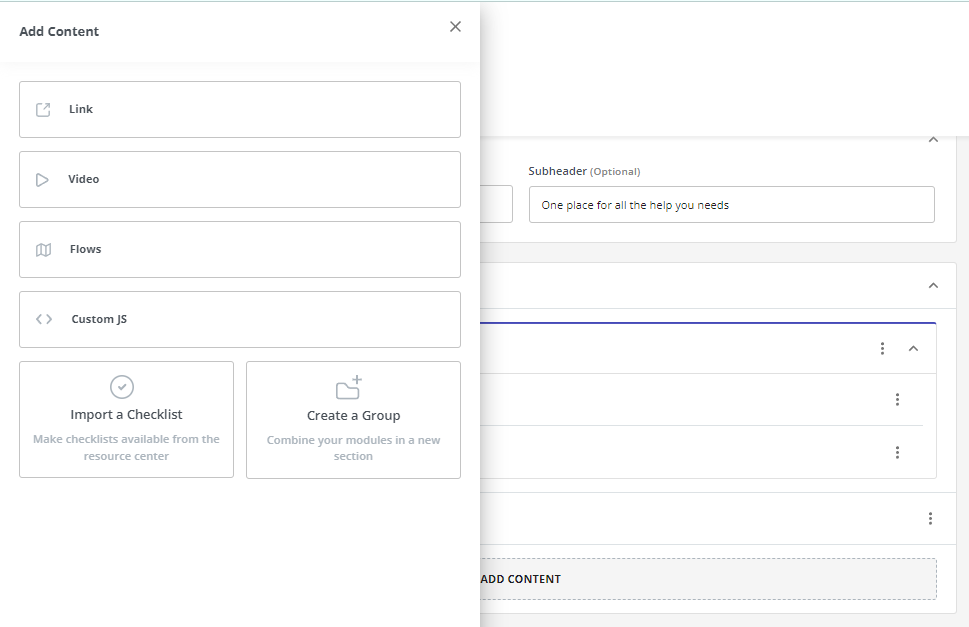
- Module segmentation: Userpilot’s segmentation settings let you hide or show specific modules within your resource center based on audience settings. This makes it possible to create modules for different user segments and hide resources that aren’t relevant to other users.
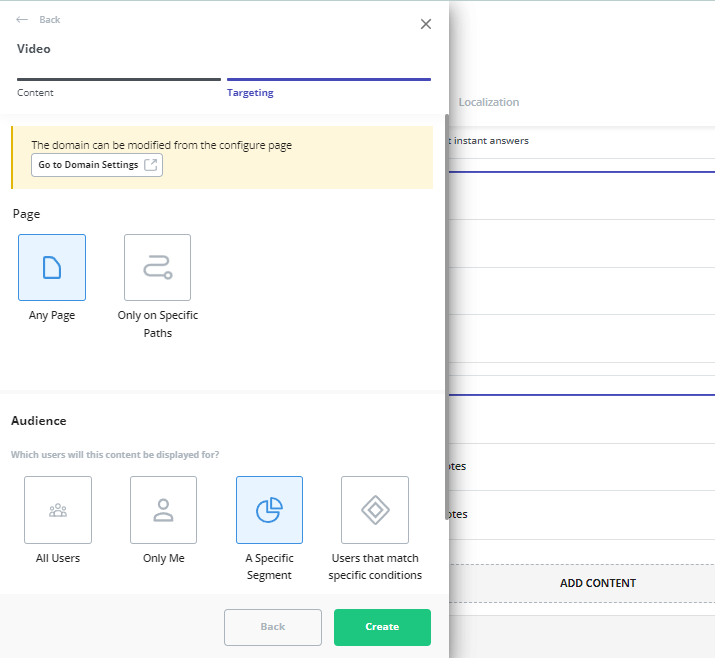
- Analytics dashboard: The dedicated analytics dashboard helps you see how many unique visitors your resource center gets, how many modules have been clicked, and the overall click rate across your user base. This will make it easier to gauge resource center performance.
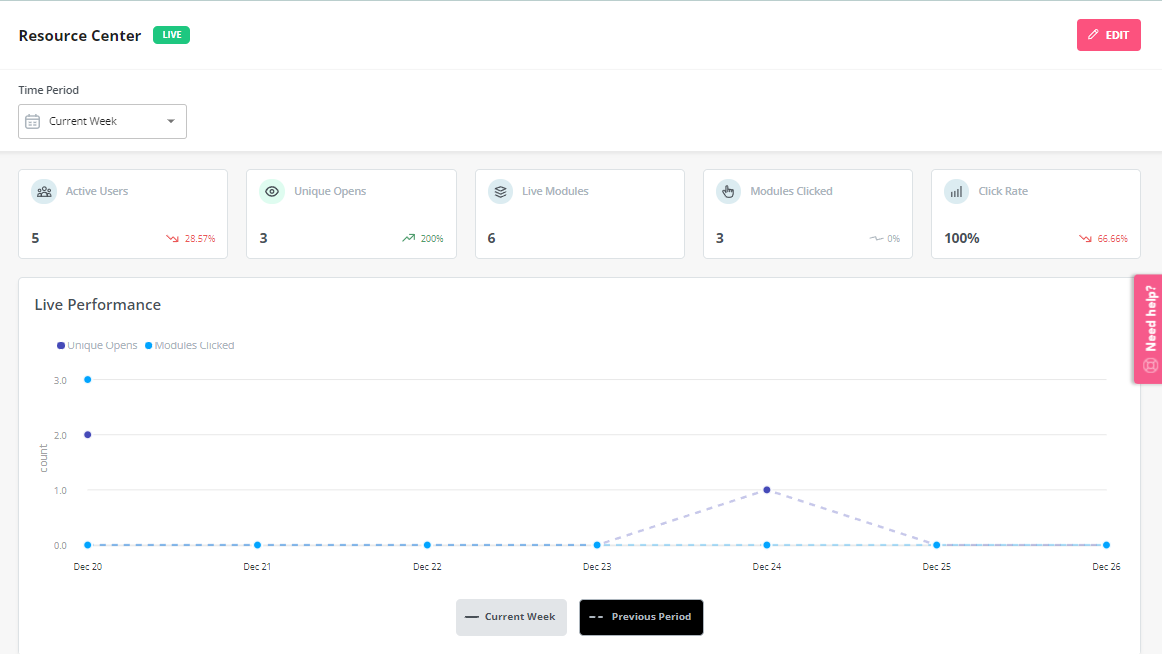
Userpilot’s in-app resource center
In-app resource centers help users find answers to their questions without needing to leave your product. Userpilot’s resource centers leverage advanced segmentation to target specific customers or use cases, have detailed analytics, and can be built using the no-code editor.
Here’s a closer look at Userpilot’s resource center editor:
- No-code editor: Userpilot lets you build in-app resource centers without needing to write any code. You can add modules like internal/external links, tutorial videos, in-app flows, custom JavaScript functions, and checklists — or group multiple modules into a single section.

- Targeted modules: Userpilot’s module segmentation features let you show/hide specific resources depending on which segment a user is in. This helps you personalize your in-app resource center and only show the resources that are most relevant to a particular user.

- Analytics dashboard: Userpilot’s resource center analytics can show you key metrics like the total number of visitors, how many modules have been clicked, and changes in the click rate to help you gauge performance. You can also sort data by a specific time period if needed.
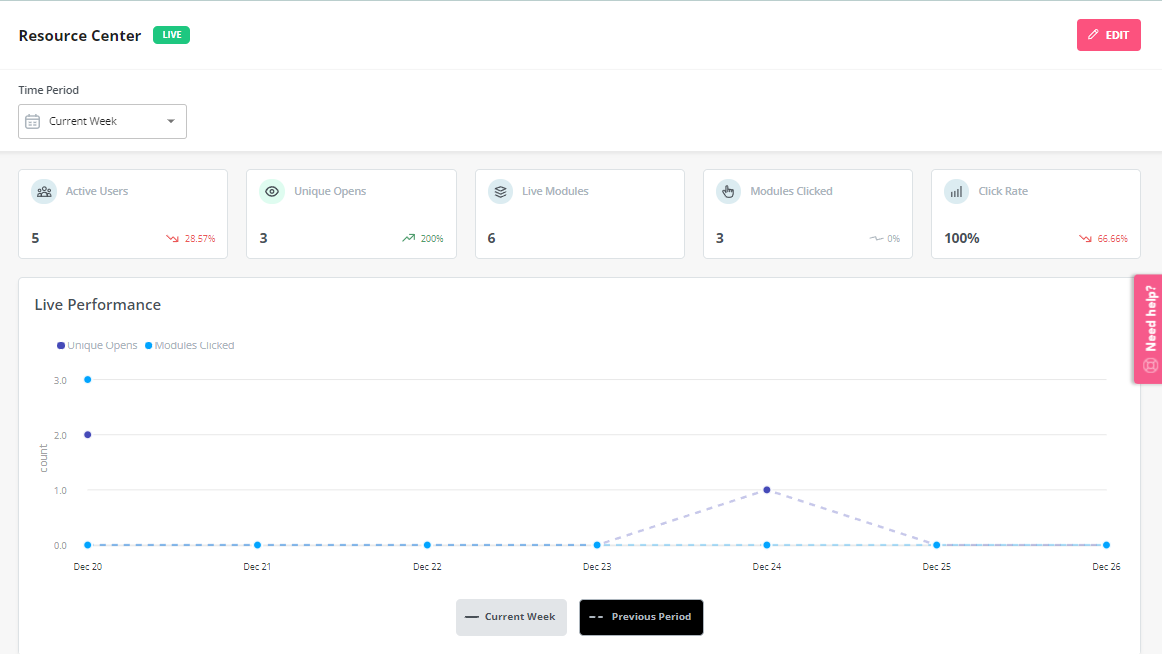
Userpilot’s onboarding checklist
Onboarding checklists help new users learn about a product and reduce their time-to-value (TTV). Userpilot checklists can be created using the no-code builder, used to trigger specific actions, and tracked using the analytics dashboard to gauge overall engagement.
Here’s how you can use Userpilot to create an advanced onboarding checklist:
- No-code builder: Userpilot’s checklist creator lets you edit the content of checklists, add tasks, style icons, and configure the triggers for when your checklist should appear. You’ll also be able to choose from five widget icons (or upload your own) and recolor the widget to match your UI.
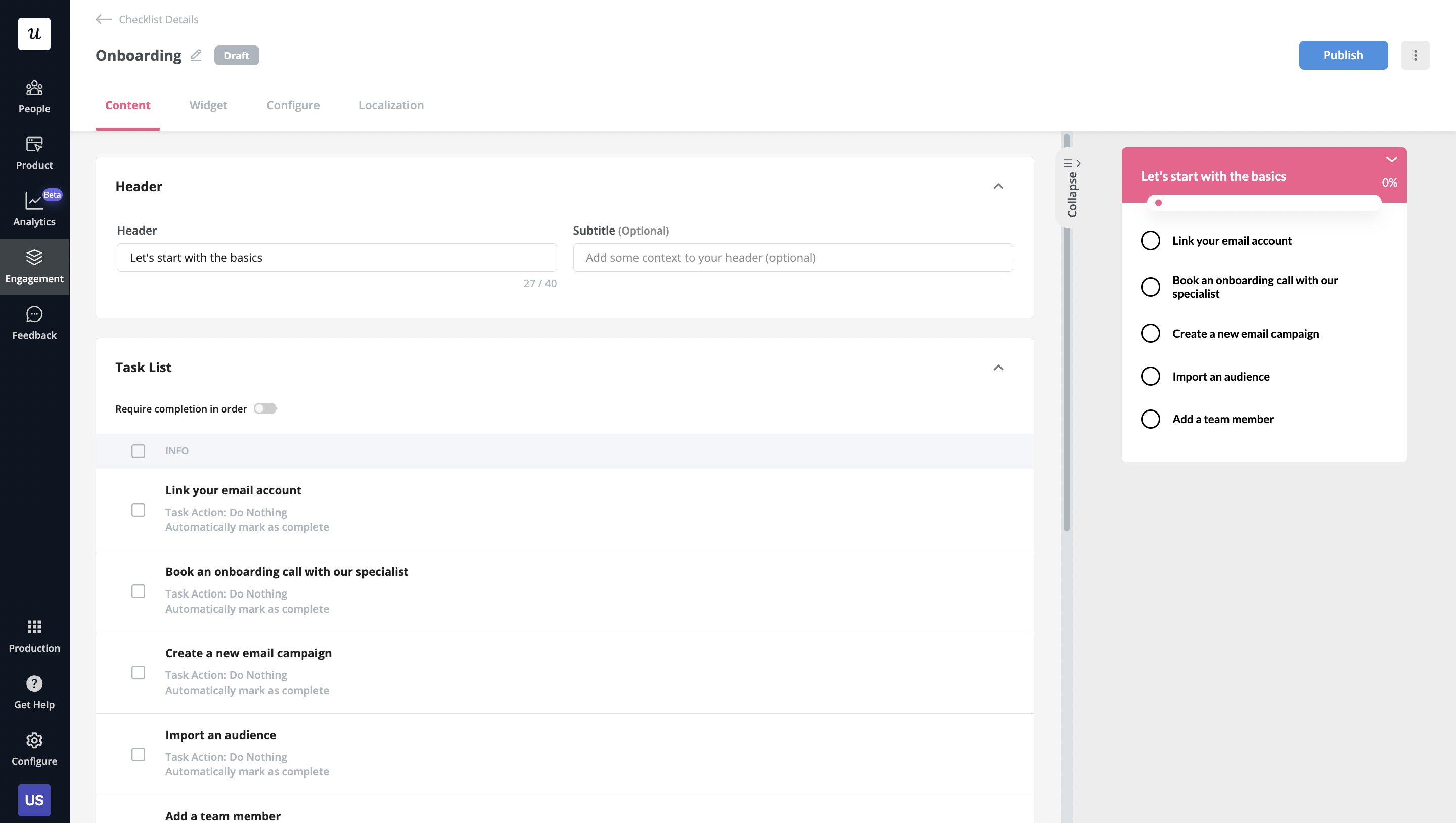
- Smart tasks: Checklist tasks can be set to trigger specific actions upon being completed, such as redirecting a user to a different page, launching an in-app flow, or running a custom JavaScript function. You can also set the conditions for when a task and action will be marked as complete.

- Checklist analytics: The Checklists dashboard shows you all relevant metrics. These include the number of live checklists you have, how many views they’ve gotten, and how many have been completed. You can also sort these analytics by segment or time period to identify trends.
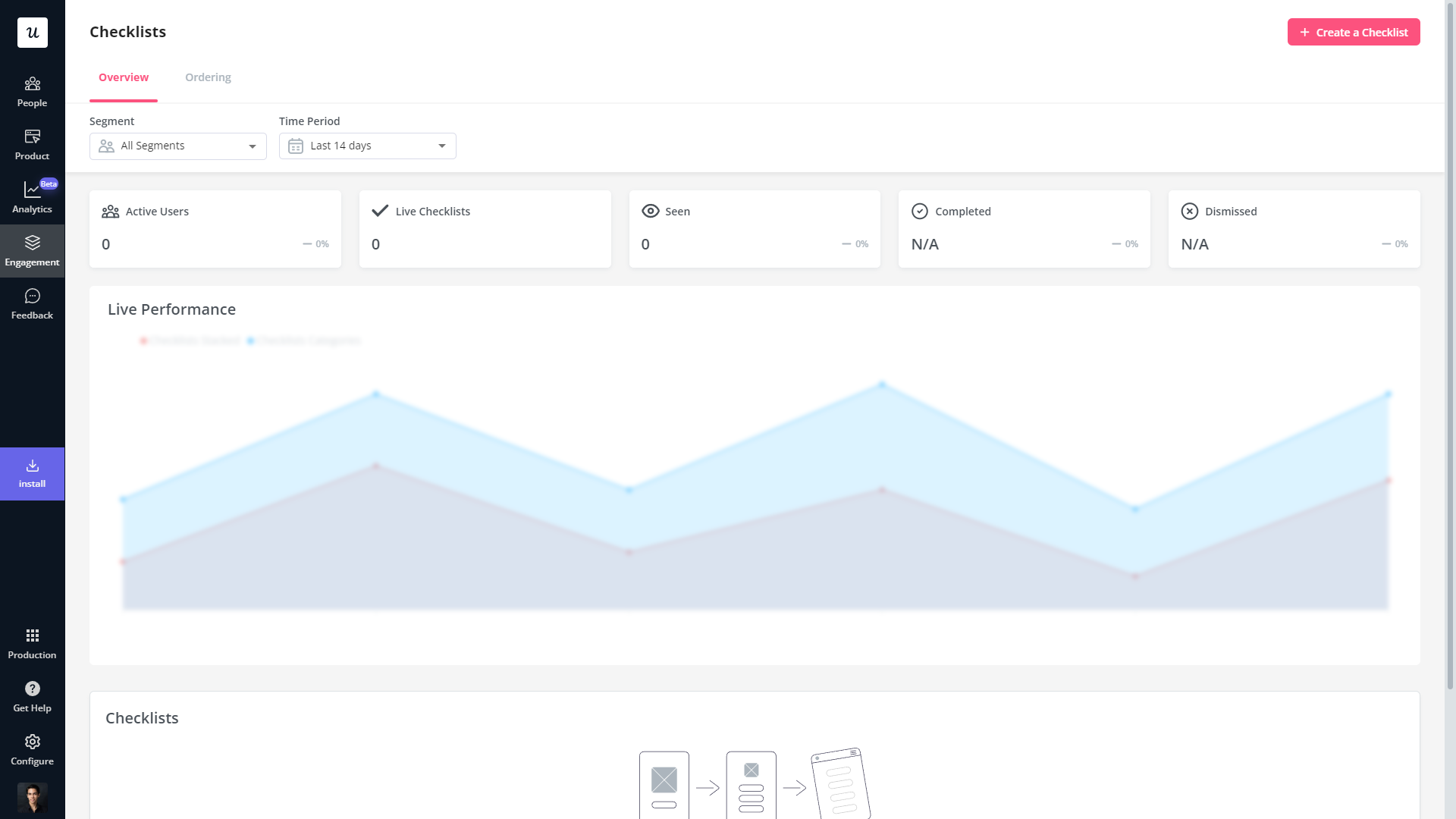
Userpilot’s in-app messaging
In-app messaging enables communication within your product to onboard new users or drive feature adoption among existing customers.
Here are a few ways you can send in-app messages using Userpilot:
- Modals: Userpilot lets you use modals to send unmissable in-app messages to your users. Simply choose from one of the six templates or create a new modal from scratch. You’ll be able to use text, emojis, images, and videos to help your modals get the message across to users.
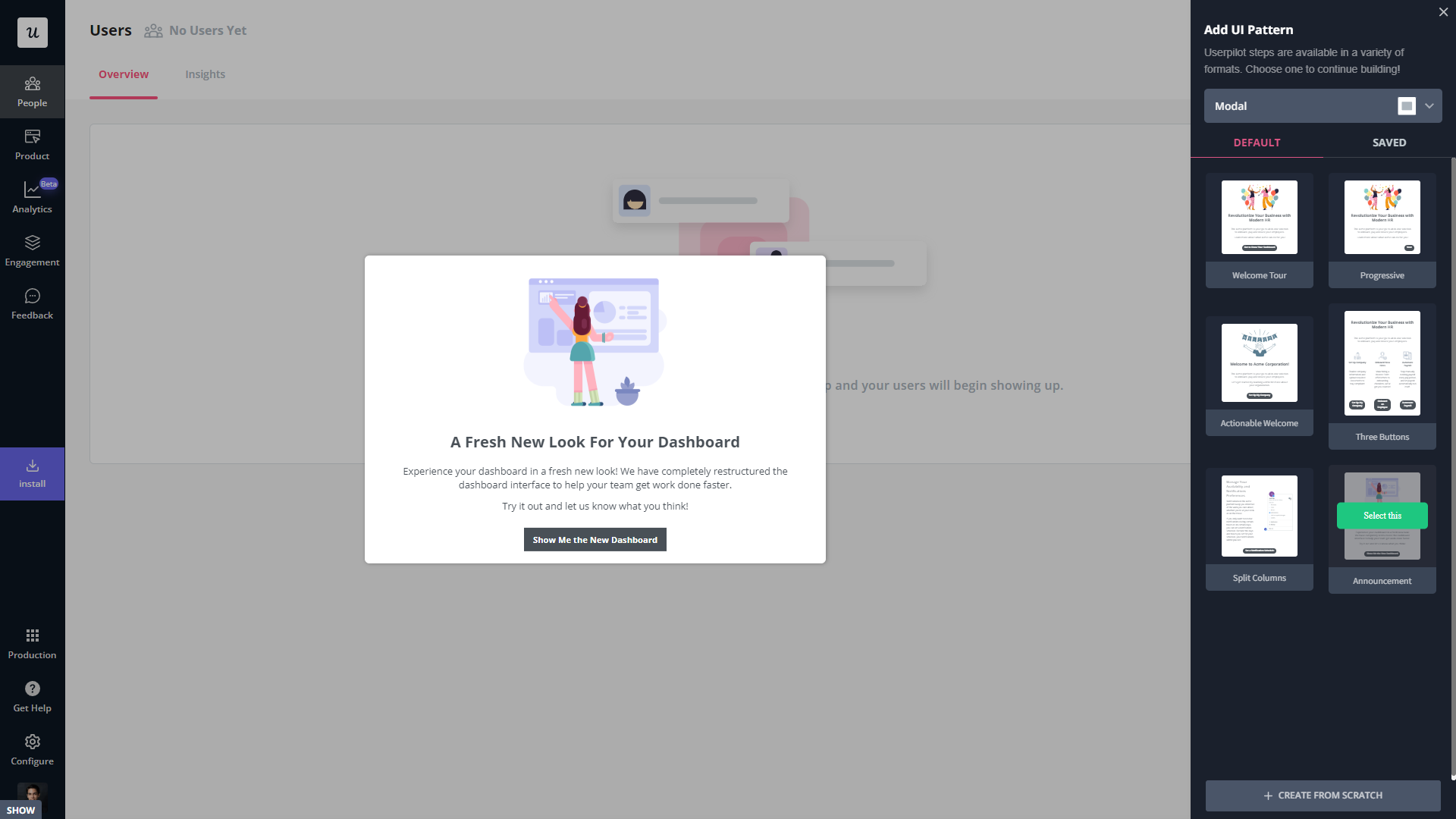
- Banners: Userpilot banners can be used to send in-app messages that are urgent but don’t need to take up the entire screen. You can also add blocks with text, emojis, images, videos, forms, custom JavaScript functions, and more to style banners to your liking.
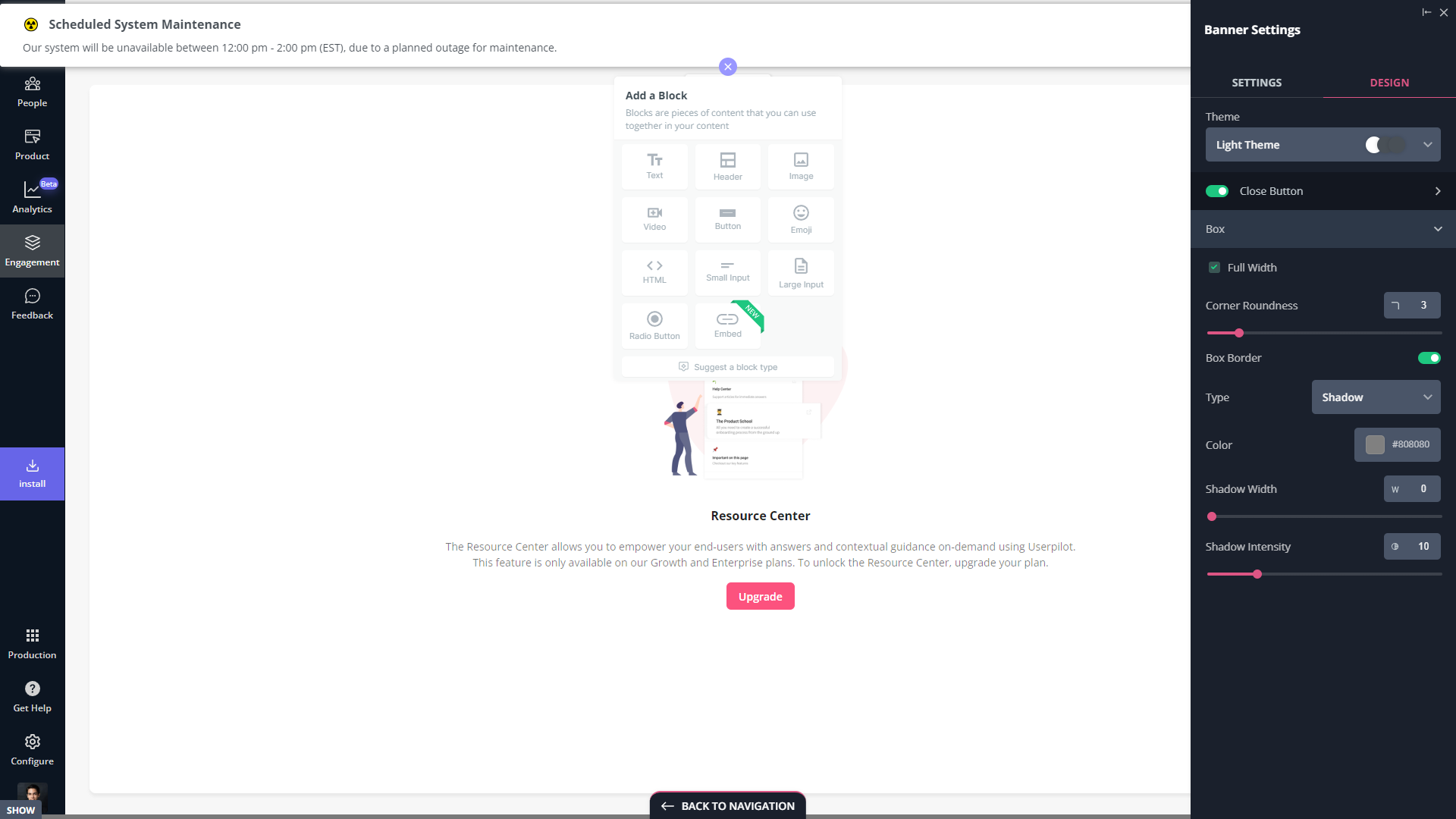
- Tooltips: They are the least intrusive form of in-app messaging as they only show up when users hover over an element or click on an info icon. You’ll be able to adjust the height, shape, color, and placement of tooltips to make them native-like.
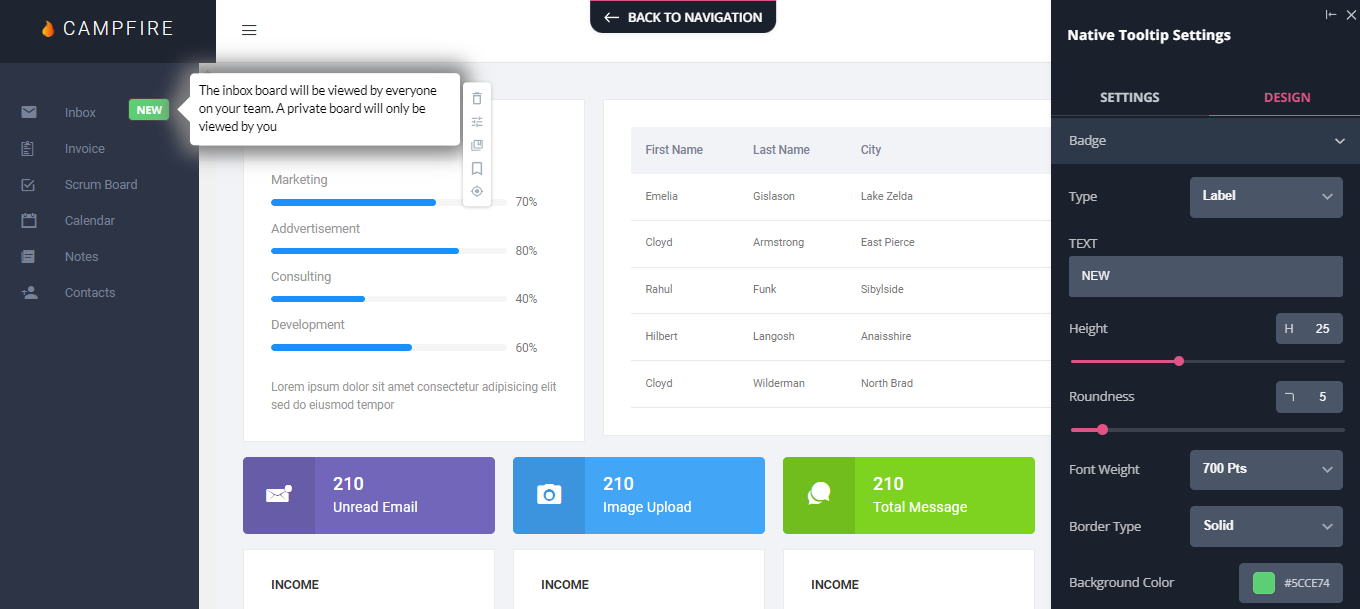
What are the pros and cons of Userpilot?
Userpilot pros
As a full-suite digital adoption platform, Userpilot has all the features you need to onboard users, track analytics, and gather feedback from customers without writing a single line of code. Here are a few pros of using Userpilot as your product growth solution:
- No-code builder: Userpilot’s Chrome extension lets you build flows, add UI elements, and tag features without writing a single line of code.
- UI patterns: There are plenty of UI patterns to choose from when using Userpilot, such as hotspots, tooltips, banners, slideouts, modals, and more!
- Startup-friendly: Userpilot’s entry-level plan gives you access to all available UI patterns so you can hit the ground running.
- Walkthroughs and flows: Build engaging interactive walkthroughs and personalized onboarding flows that target specific segments of your user base.
- Self-service support: Build an in-app resource center to help users solve problems, customize its appearance to align it with your brand, and insert various types of content (videos, flows, or chatbots) to keep your customers satisfied.
- A/B testing: Userpilot’s built-in A/B testing capabilities will help you split-test flows, iterate on the best-performing variants, and continually optimize based on user behavior.
- Feedback collection: Userpilot has built-in NPS surveys with its own unified analytics dashboard and response tagging to help you retarget users. There are other survey types to choose from and you can even create your own custom survey.
- Survey templates: There are 14 survey templates to choose from so you can gather feedback on specific features or run customer satisfaction benchmarking surveys like CSAT and CES.
- Advanced analytics: Userpilot lets you analyze product usage data, monitor engagement on all in-app flows, and use the data to create user segments that are based on behaviors instead of demographics.
- Event tracking: Userpilot’s no-code event tracking lets you tag UI interactions (hovers, clicks, or form fills) and group them into a custom event that reflects feature usage.
- Third-party integrations: Userpilot has built-in integrations with tools like Amplitude, Mixpanel, Kissmetrics, Segment, Heap, HubSpot, Intercom, Google Analytics, and Google Tag Manager so you can share data between all the solutions in your tech stack.
Userpilot’s cons
Of course, no tool is perfect and there are a few cons to consider before choosing Userpilot as your user onboarding or product growth solution:
- Employee onboarding: Currently, Userpilot only supports in-app customer onboarding.
- Mobile apps: Userpilot doesn’t have any mobile compatibility which could make it difficult for developers with cross-platform applications to create a consistent user experience for both versions of their product.
- Freemium plan: There’s no freemium Userpilot plan so those bootstrapping their startup and need sub-$100 solutions should consider more affordable onboarding platforms like UserGuiding or Product Fruits.
What do users say about Userpilot?
Most users laud Userpilot for its versatile feature set, ease of use, and responsive support team:
I recently had the pleasure of using Userpilot, and I must say it exceeded all my expectations. As a product manager, I’m always on the lookout for tools that can enhance user onboarding and improve overall user experience. Userpilot not only delivered on these fronts but also went above and beyond with its impressive new features, unparalleled ease of use, and truly exceptional customer support.
What truly sets Userpilot apart is its outstanding customer support. Throughout my journey with Userpilot, the support team has been responsive, knowledgeable, and genuinely dedicated to helping me succeed. Whenever I had a question or encountered an issue, their support team was always there to assist promptly, going above and beyond to ensure my concerns were addressed effectively.

Source: G2.
Of course, other users are also kind enough to share constructive criticism regarding specific features like event tracking filters:
“The filtration while analyzing specific events is a little confusing. Understanding of custom properties and data management configuration could have been more organised.”

Source: G2.
Userpilot’s pricing
Userpilot’s transparent pricing ranges from $249/month on the entry-level end to an Enterprise tier for larger companies.
Furthermore, Userpilot’s entry-level plan includes access to all UI patterns and should include everything that most mid-market SaaS businesses need to get started.

Userpilot has three paid plans to choose from:
- Starter: The entry-level Starter plan starts at $249/month and includes features like segmentation, product analytics, reporting, user engagement, user feedback, and customization.
- Growth: The Growth plan starts at $499/month and includes features like resource centers, advanced event-based triggers, unlimited feature tagging, AI-powered content localization, EU hosting options, and a dedicated customer success manager.
- Enterprise: The Enterprise plan uses custom pricing and includes all the features from Starter + Growth plus custom roles/permissions, access to premium integrations, priority support, custom contract, SLA, SAML SSO, activity logs, security audit and compliance (SOC 2/GDPR).
Conclusion
There you have it.
It should be easier now to make an informed decision whether Intercom is your go-to option for In-app messaging. Ultimately, the best choice will depend on your product and current needs.
If you’re looking for a better alternative to Intercom for In-app messaging, book a Userpilot demo today to experience firsthand how it can enhance your user experience and drive product growth!
![]()
Looking for a Better Alternative for In-app messaging? Try Userpilot


